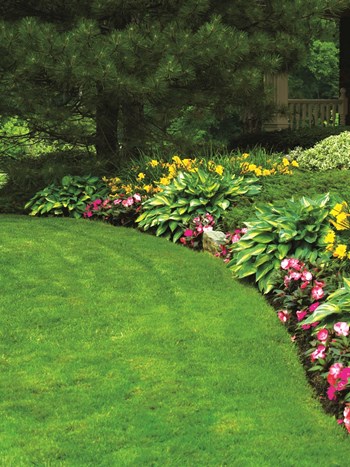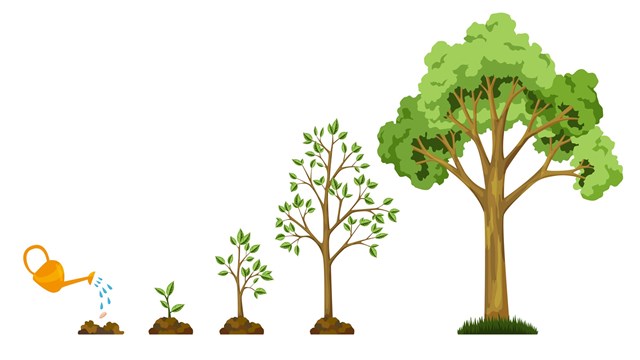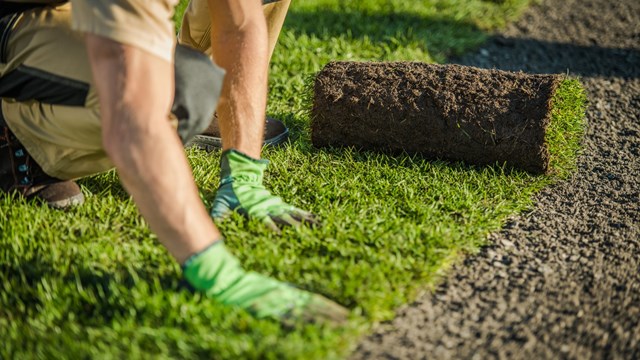
In the face of rising water costs, maintenance costs, and a continued depressed housing market, many community associations are finding long-term savings through new landscape strategies that also help our environment. Eco-friendly landscaping practices are not just the domain of the nature lover anymore. They can mean significant returns on your investment.
Aesthetics and Ecology
The implementation of an eco-friendly landscaping strategy does not mean only using tall grasses or having a loose unkempt look on your property.
There are many strategies available and HOAs considering these types of strategies have a long-term goal in mind: to save money and help the environment, according to Tom Lupfer, a landscaper and the chairman of the Sustainable Landscaping Committee for the Landscaping Contractors Association chapter in Illinois. “Sustainable landscaping is not a design style, it is a thought process,” says Lupfer. “You can have anything from a formal landscape design to a tall grass prairie or anything in between. If you manage it carefully and appropriately, you can have a large amount of turf grass. You don’t have to give up the lawn to be sustainable.”
“The whole picture can be addressed,” continues Lupfer. “You need to make sure you are doing things according to best practices. For example, we use compost teas instead of synthetic fertilizer and pesticide use, which also saves a lot of money.”
Low-maintenance is a common theme in eco-friendly landscaping, says Aaron S. Kurdyla, director of operations for High Tech Landscapes Inc. in Branchburg. “Low maintenance means that you don’t have to do a lot of plant care, which generally means less watering. I always recommend a few native species. There’s been a more conscious approach by HOAs to use plants that are native to New Jersey.”
The native plant society of New Jersey (www.npsnj.org) lists New Jersey native plants by county. These lists include herbaceous varieties as well as trees and shrubs.
Sustainable design is more modern now and people are wanting to see it more and more,” continues Kurdlya. “We are moving away from the clipped yews and evergreens and seeing more grasses and perennials.”
Some Meaningful Strategies
Common issues to address include appropriate plantings and storm water runoff. “When you are redesigning it is critical to put the right plant in the right place,” says Lupfer. “If the bushes under the window have been trimmed five times this year, that’s because they are not right for that place,” he explains.
“There are many kinds of eco-friendly landscape solutions,” says Michael Amato of Amato Landscape Contractors in Union, “Safer salt is one thing that more landscapers are using for snow removal. Calcium chloride is better on grass.”
And eco-friendly landscaping can mean thinking creatively to save money, continues Lupfer. “If you use your money to transplant that bush to another spot and put in a plant that suits that spot, you will save money in the long run. A careful review of the current maintenance program can yield hidden opportunities to save money. A change here will free up resources to invest in other areas.”
One of the first things to be put on the chopping block is the ubiquitous lawn, although they don’t necessarily have to go. Lawns also usually require copious amounts of fertilizer and pesticides, which are generally applied as chemicals on a regular schedule. Creating a healthy environment is much like creating a healthy body: the more toxins that are added, the poorer the systems will function, leading to eventual breakdown.
“A lot of condo communities that we are maintaining were built in the boom of the ‘80s and ‘90s and they have massive lawns,” says Kurdyla. “Now, they are trying to find the best conservation method because so many of the lawns were over-planted.”
Moderate use of chemicals is another aspect of eco-friendly landscaping practices, says Kurdyla, “We only use pesticides when weeds or insects are present, then we’ll just concentrate on using it in a certain place. We never blanket spray.”
An integrated landscape approach will also become a more sustainable system, says Kurdyla. “You get pest problems when you put in plants that are fighting to stay alive, but healthy gardens take better care of themselves.”
“When you put down herbicides, for example, you kill not only the harmful elements, but many of the beneficial microbes that foster life and growth in the soil,” adds Lupfer. “The soil becomes barren, in a way, and has to be supplemented artificially, which means more chemicals.”
Storm water runoff is a major area of concern for eco-friendly landscapes. “Whenever you get a storm where everything is draining is storm runoff and it’s becoming more and more of an issue,” says Amato. “A lot of people are going green by recycling rain water and doing a rain water harvest. That’s when you collect your storm water in a barrel or well or some sort of container, and it can be done underground, then you reuse that water for watering your plants, irrigating your lawn or even washing your car. The state of New Jersey is encouraging this practice by offering tax breaks in certain areas for recycling your rain water, so that’s a big incentive for a lot of people.”
Money Talks
In difficult economic times like the ones we have seen recently, it can be a struggle to convince people to consider redesigns that may be seen as expensive or outside the traditional idea of a residential landscape. But these solutions help save money as much as help the environment.
HOAs can save through a variety of ways, says Ruth Bowers, owner of Linnaea Design in Highland Park. “By using native plants, you’ll have much lower water costs, since natives will grow and thrive with less added water in the form of irrigation so they can survive on the rainfall that we get in New Jersey. Native trees are so well adapted to the area. I always recommend the Northern Red Oak, New Jersey’s state tree.”
“Another way to save money is by keeping control of irrigation, only watering when water is needed instead of according to a timer,” says Lupfer. “You can save 60-70 percent on your water bill. You don’t have to put in new systems or spend any money up front. This is something everyone can do right now.”
“Additionally, HOAs can save money through materials management,” continues Lupfer. “Many HOAs bring in large amounts of bulk items like mulch, and often the mulch layer is still intact. I’ve seen hundreds of yards of mulch brought in for sites that already have enough mulch. The two- or three-inch layer of mulch can actually be bad for plantings if it piles up and strangles them. The reason that people usually want more mulch is aesthetic, so we can use dye on the existing mulch to freshen it up at a much lower cost, making it look new.”
Timelines
Major overhauls like this can be expensive and physically disruptive to the sites where entire areas are being re-landscaped. In addition, starting small may be a good way to acclimate residents to a new aesthetic or landscape strategy.
Using professionals who know what they are doing is essential to the success of any project. It’s best, says Kurdyla, to work with a landscape or design professional, or at the very least, someone who is very knowledgeable able about local plant communities.
Phasing can serve another purpose, as well: educating the client, says Lupfer, who advises slowly implementing changes over time. “Once you have established a track record of trust that you will produce a beautiful, as well as ecologically-conscious landscape, people will be more likely to trust you with ideas that are further outside the box of what they expect from a landscape plan. They get it. For example, the first year, I will recommend planting perennial bulbs instead of tulips, and change the fertilizing program. The next year we continue transitioning to a more sustainable landscape and maintenance plan.”
Doing a project in phases also eases the financial burden of installation, says Lupfer. “The cost of new construction is large. The initial investment can seem overwhelming but it should be incorporated into your reserve studies. You can see that over five, 10, 50 years, the savings of a sustainable landscape will come back to you. A good example is permeable pavers. They are more expensive going in, but have a 50-year life span. Plus you gain more usable land, since you require less land for drainage solutions like retention ponds or drains.”
“The whole goal of moving toward sustainability is to subtly change it into a more vibrant-looking landscape and create a healthier environment. It should be a process of transitioning from a traditional landscape to a more sustainable one. A healthier landscape means that plants don’t need as much attention, since they are growing as they should and are not afflicted by disease and don’t need artificial food to keep them alive and flourishing.” n
Denton Tarver is a freelance writer and a frequent contributor to The New Jersey Cooperator. Staff Writer Christy Smith-Sloman contributed to this article.






Leave a Comment